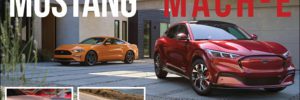
It’s almost enough to make you think Ford plans to offer electric cars shoppers may actually want to buy.
The extended debut of the 2021 Ford Mustang Mach-E electric SUV culminated in its formal unveiling in an aircraft hangar last November, just before the start of media days at the Los Angeles Auto Show.
The fact that the hangar sat next door to Tesla’s design studio in Hawthorne was, according to a smiling Bill Ford, “a coincidence.”
Not a compliance car
Ford invited a handful of journalists to a lengthy briefing on its then-unnamed EV at the company’s headquarters in Dearborn, Michigan, a few weeks before the LA reveal. Unexpectedly, executives gave a full rundown of the twists and turns in the development process—including how radically it changed after Jim Hackett replaced Mark Fields as CEO in May 2017.
At that time, the company’s designers and product developers were midway through the creation of what the company itself called a “compliance car” to replace its outdated, uncompetitive Focus Electric hatchback.
The battery-electric Focus pretty much defined the term “compliance car.” It sold in low volumes (10,000 over almost a decade), its range never competed with the best EVs (76 miles from 2012 through 2016, and 115 miles thereafter), and it was available only in a limited number of regions. The tone was set at the 2011 launch, when Ford managers spent a great deal of time explaining all the reasons US drivers wouldn’t buy it—and no time on how the company planned to explain the advantages of electric cars.
Few automakers have been quite so explicit as Ford in acknowledging that it had started with a functional but unexciting EV that was intended solely to meet regulatory requirements. The difference Hackett brought during the summer and fall of 2017, the Mach-E team said, was simply to say, “Why aren’t we making it a car people will want to buy?”
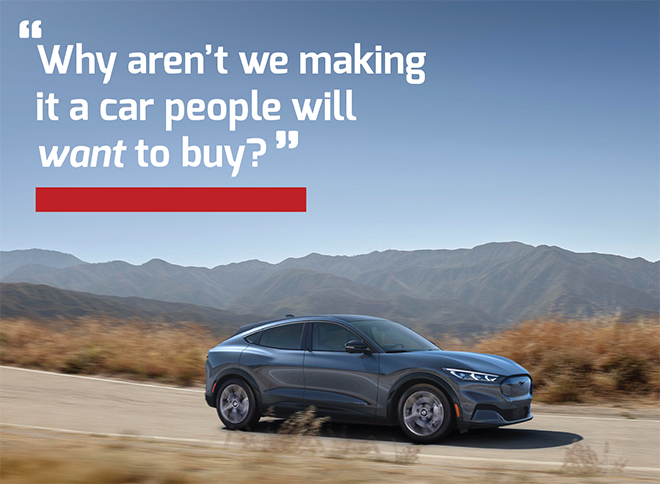
“Mustang-inspired”
Over the next two years, Ford marketing materials called the future model a “Mustang-inspired, 300-mile electric SUV.” Rumors said it was to be dubbed “Mach 1,” though a backlash from Mustang enthusiasts seemed to doom that label. It ultimately evolved into “Mach-E” (with a hyphen to ensure it didn’t become “Mache”).
Two years ago, a few reporters who were shown an early model of the revised electric car described it as “literally a four-door Mustang SUV.” And that’s exactly what Ford unveiled, with one hugely important new detail: It’s not just “inspired” by the 55-year-old pony car.
The battery-electric crossover utility is actually becoming a part of the Mustang model line. It’s the first four-door Mustang, the first all-wheel-drive Mustang, and the first Mustang powered by electricity rather than internal combustion.
It’s a bold move by Ford, and it reflects the reality that utility vehicles blending wagon or hatchback practicality with higher ride height and all-wheel drive are displacing passenger sedans across the globe. Two-door coupes like the classic Mustang represent a waning segment, so adding an SUV to the Mustang line simply aligns the model with the auto market of the new century.
More importantly, the new model adds immediate brand recognition, sex appeal, and a performance image to electric cars—something only Tesla has done at scale so far. “Ford has a new electric Mustang?” Ford hopes shoppers will say. “Gee, it must be fast and cool-looking. Let’s at least check that out.”
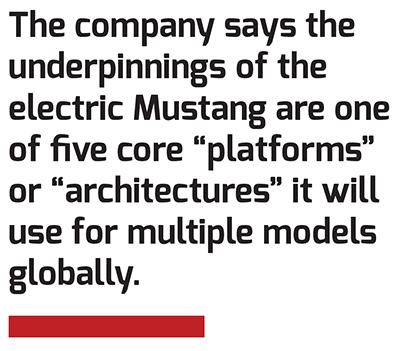
Two packs, lots of power
Once Ford’s product team got the OK to make a genuinely appealing electric utility, it had to become a true Mustang, with the full participation of the Mustang design and performance teams. That meant a longer nose with a more traditional (blanked-off) “grille,” and power delivered to the rear axle, not the front, for its main propulsion.
The company says the underpinnings of the electric Mustang are one of five core “platforms” or “architectures” it will use for multiple models globally. A more luxury-focused Lincoln crossover will likely be the next vehicle on the platform, though perhaps not until the 2022 model year.
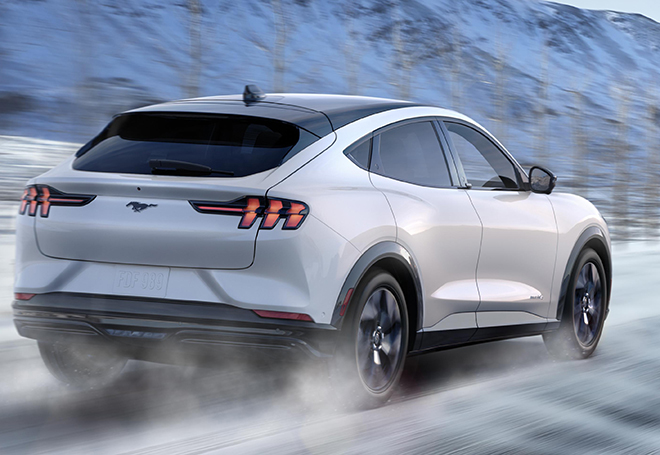
The 2021 Mustang Mach-E will use a liquid-cooled battery pack offered in two capacities: 75.7 and 98.8 kWh. At the Los Angeles launch, Ford laid out five trim levels for the Mach-E.
The base Select model has rear-wheel drive as standard, offering AWD as a $2,700 option. It uses the smaller battery size and comes with 18-inch wheels. The better-equipped Premium has 19-inch wheels, and comes in Standard Range or Extended Range versions, corresponding to the two pack sizes.
A California Route 1 version uses the larger battery, but offers only rear-wheel drive, and it’s the one targeting a 300-mile EPA range rating—a compelling marketing advantage. Targeted acceleration from 0 to 60 mph for those models is quoted at roughly 5.5 to 6.5 seconds.
The high-performance GT variant will be the hot rod, with 20-inch wheels and 0-60 acceleration in the mid-3-second range. Its motors have the highest output, targeting 342 kW (459 hp). Other models have outputs from 190 kW (255 hp) to 248 kW (332 hp), depending on pack size and number of motors (all performance specifications are preliminary targets).

Ford opened the reservation list for the Mach-E during the livestreamed launch event, with a deposit of $500 for a place in the queue. The fifth model it offered was a special First Edition version, at $61,000, which it said sold out in 10 days—though the company has not revealed how many it plans to produce.
The first Mach-E models in production will be the First Edition and Premium versions, which Ford says are to go on sale in the US late this year. The Select and Route 1 models will follow in early 2021, and the GT will lag slightly, with a quoted on-sale date of Spring 2021.
US pricing starts at $44,495 for the base Mach-E Select, and ranges into the 60s for well-equipped GT versions.

Priority for Europe?
Ford hasn’t revealed its planned production volume, though global sales of 30,000 to 60,000 seem reasonable. Some analysts suggest, however, that a large share of early production may go to European Union markets due to stringent new limits on CO2 emissions that went into effect on January 1. To avoid fines that could run to billions of euros, manufacturers must sell more zero-emission vehicles in the EU—and fast.
Meanwhile, the US regulatory environment remains unsettled. Along with BMW, Honda, and Volkswagen, Ford agreed with the California Air Resources Board to abide by a slightly altered version of the state’s emission requirements—including increasing sales of zero-emission vehicles—so that’s likely where the largest number of early Mach-E models will appear.
Roughly a dozen other states have those same zero-emission-vehicle sales mandates, but Ford’s home state is not one of them. Michigan, in fact, remains one of the least hospitable states in which to own an EV. Challenges include sparse charging infrastructure, a lack of state incentives for EV purchases, and an overt hostility to sales and service of Tesla vehicles.
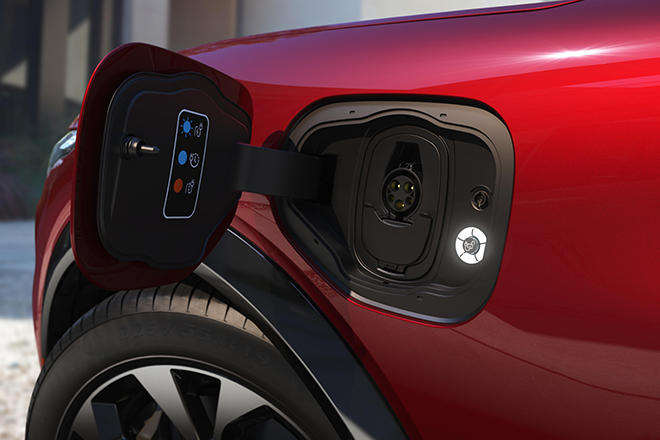
Getting Michigan up to speed
But perhaps a home-grown, sexy, high-performance electric car that ticks the “AWD SUV” box could get Michigan auto-industry folks excited about electric cars. Prompted by a boot in the backside from Tesla, they know perfectly well that’s where the global industry has to head, whether they like it or not.

If a Mustang can go all-electric, and offer high performance and long range in a package that’s also an SUV (more or less), anything could be possible—which is why the most radical thing about the Mach-E is that it’s actually a Mustang.
Old-line ‘Stang fans may grumble and spit. For them, Ford is taking great pains to point out that the electric car is an addition to the traditional lineup of Mustang coupes, not a replacement. (Translation: Just ignore it if you don’t like the idea of an EV. Or an SUV. The noisy two-doors are right over here.)
But replacing the underwhelming, almost resentfully-developed Focus Electric with a fast, appealing electric car that’s really a Mustang? That’s about as far from a compliance car as you can get.
Ford provided airfare, lodging, and meals to allow Charged to bring you this first-person report from Dearborn and Los Angeles.
MORE: Ford’s electric SUVs and pickups are on the way
This article appeared in Charged Issue 47 – January/February 2020 – Subscribe now.
source https://chargedevs.com/features/2021-ford-mustang-mach-e-an-electric-crossover-with-the-soul-of-a-mustang/
No comments:
Post a Comment